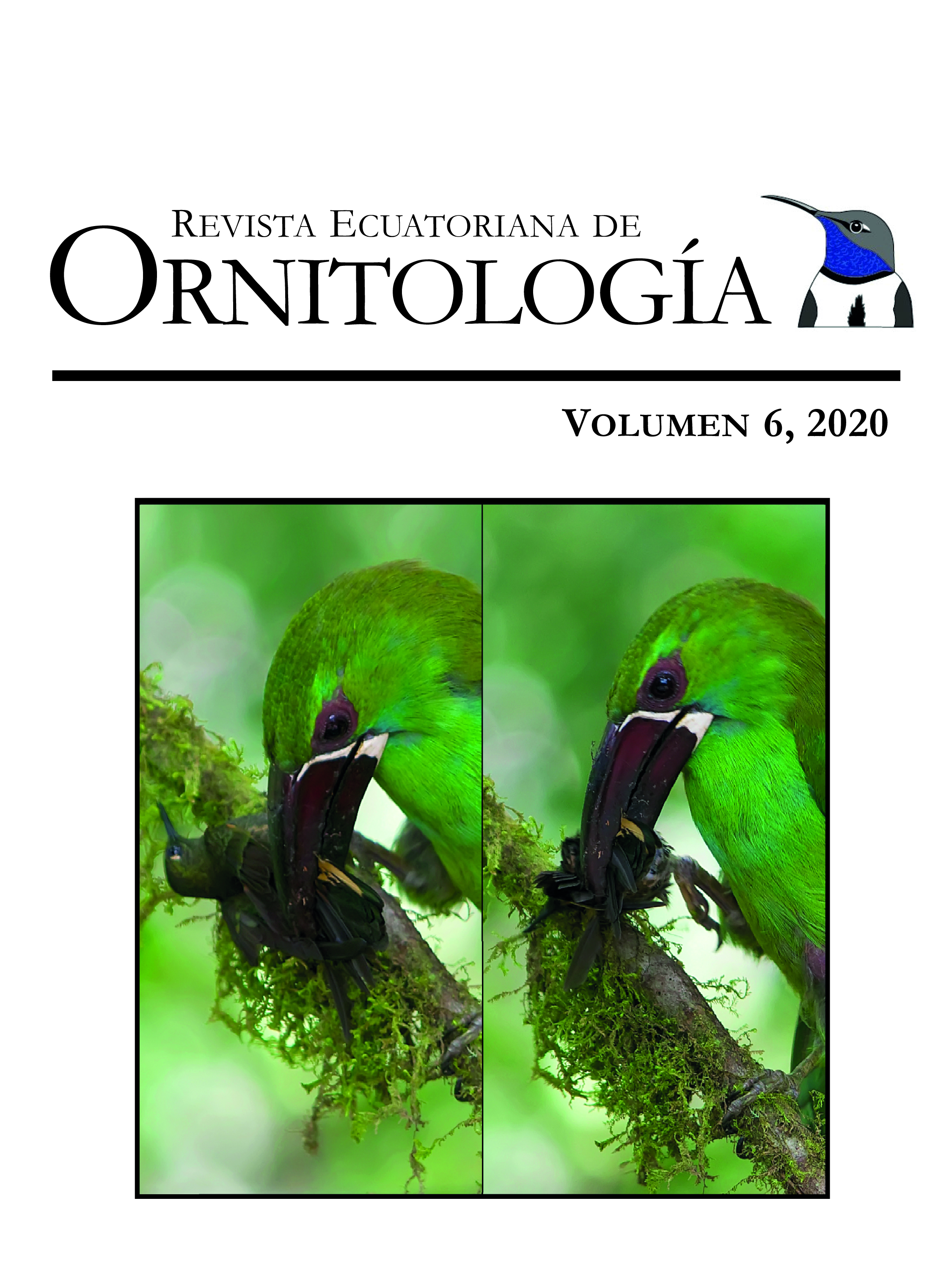OBSERVATIONS ON THE PARENTAL CARE OF THE YELLOW-BELLIED ELAENIA Elaenia flavogaster subpagana
DOI:
https://doi.org/10.18272/reo.vi6.1442Keywords:
Costa Rica, Elaenia, feeding, nestling, parental careAbstract
We observed three nests of Yellow-bellied Elaenia Elaenia flavogaster subpagana in La Selva, Costa Rica. One nest had a single nestling, which was observed for 21 h in order to document incubation, breeding and feeding behaviors. We quantified number of visits per h to the nestling, as well as food transfer events and fecal sac removal, and confirmed that two parents fed the nestling. Adults visited the nest 4.9 ± 0.6/h/nestling on average. We observed 18 feeding events between adults, and five food transfer episodes of the incoming adult to the incubating adult, and then to the nestling. Food items brought to the nest included Diptera, Coleoptera, Phasmatodea, Hymenoptera, Araneae and berries.
Downloads
References
Brodkorb, P. (1943). Two new flycatchers of the genus Elaenia. Ann Arbor, Michigan. University of Michigan.
Chatellenaz, M.L., & Ferraro, L.I. (2000). Materiales vegetales y fúngicos utilizados por aves en la construcción de nidos en el noreste Argentino y Paraguay. Comunicaciones Científicas y Tecnológicas. Universidad Nacional del Nordeste. Corrientes, Argentina. Pp 1-4.
Crowell, K.L. (1968). Competition between two West Indian Flycatchers, Elaenia. Auk 85:265-286.
ffrench, R. (1991). A guide to the birds of Trinidad and Tobago. Second edition. Ithaca, New York: Comstock Publishing Associates, Cornell University Press.
Fitzpatrick, J.W., Bates, J.M., Bostwick, K.S., Caballero, I.C., Clock, B.M., Farnsworth, A., Hosner, P.A., Joseph, L., Langham, G.M., Lebbin, D.J., Mobley, J.A., Robbins, M.B., Scholes, E., Tello, J.G., Walther, B.A., & Zimmer, K.J. (2004). Family Tyrannidae (Tyrant-flycatchers). In J. del Hoyo, A. Elliot & D.A. Christie (Eds.), Handbook of the Birds of the World. Vol. 9. Cotingas to Pipits and Wagtails (pp. 170-463). Lynx Ediciones, Barcelona.
Foster, M.S. (1987). Feeding methods and efficiencies of selected frugivorous birds. Condor 89:566-580.
Hosner, P., & Kirwan, G.M. (2019, May 22). Yellow-bellied Elaenia (Elaenia flavogaster). In J. del Hoyo, A. Elliott, J. Sargatal, D.A. Christie, & E. de Juana (Eds.), Handbook of the Birds of the World Alive. Lynx Edicions, Barcelona. (URL: https://www.hbw.com/node/57142).
Marini, M.A., & Cavalcanti, R.B. (1998). Frugivory by Elaenia flycatchers. Hornero 15:47-50.
Matysioková, B., & RemeÅ¡, V. (2014). The importance of having a partner: male help releases females from time limitation during incubation in birds. Frontiers in Zoology 11:24. doi.org/10.1186/1742-9994-11-24.
Okahisa Y., & Sato, N. (2013). Mutual feeding by the shining cuckoo (Chrysococcyx lucidus layardi) in New Caledonia. Notornis 60:252-254.
Oniki, Y., de Melo Jr, T.A., Scopel, E.T., & Willis, E.O. (1994). Bird use of Cecropia (Cecropiacae) and nearby trees in Espirito Santo state, Brazil. Ornitologia Neotropical 5:109-114.
Proctor, N.S., & Lynch, P.J. (1993). Manual of ornithology: Avian structure & function. New Haven, Connecticut: Yale University Press.
Sherry, T.W. (1984). Comparative Dietary Ecology of Sympatric, Insectivorous Neotropical Flycatchers (Tyrannidae). Ecological Monographs 54:313-338.
Skutch, A.F. (1947). A nestling of the plumbeous kite in Ecuador. Condor 49:25-31.
Skutch, A.F. (1960). Life histories of Central American birds II. Pacific Coast Avifauna No. 34, Cooper Ornithological Society, Berkeley, California.
Smith, S.M. (1980). Demand behavior: a new interpretation of courtship feeding. Condor 82: 291-295.
Stutchbury, B., Morton, E.S., & Woolfenden, B. (2007). Comparison of the mating systems and breeding behavior of a resident and a migratory tropical flycatcher. Journal of Field Ornithology 78:40-49.
Warner, D.W., & Mengel. R.M. (1951). Notes on Birds of the Veracruz Coastal Plain. Wilson Bulletin 63:288-295.
Downloads
Published
How to Cite
Issue
Section
License
Los autores que publiquen en la Revista Ecuatoriana de Ornitología aceptan los siguientes términos:
- Los autores/as conservarán sus derechos de autor y garantizarán a la revista el derecho de primera publicación de su obra, el cuál estará simultáneamente sujeto a la Licencia de Reconocimiento No Comercial de Creative Commons.
- Los autores/as podrán adoptar otros acuerdos de licencia no exclusiva de distribución de la versión de la obra publicada, pudiendo de esa forma publicarla en un volumen monográfico o reproducirla de otras formas, siempre que se indique la publicación inicial en esta revista.
- Se permite y se recomienda a los autores difundir su obra a través de Internet en su repositorio institucional, página web personal, o red social científica (como ResearchGate o Academia.edu).


